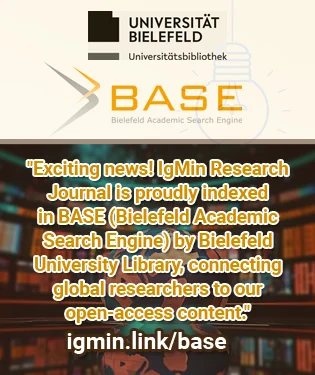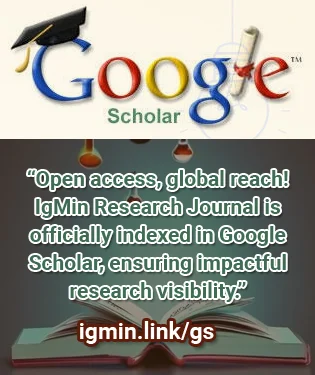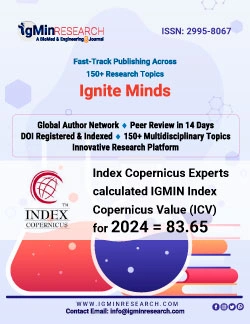Open Access Policy refers to a set of principles and guidelines aimed at providing unrestricted access to scholarly research and literature. It promotes the free availability and unrestricted use of research outputs, enabling researchers, students, and the general public to access, read, download, and distribute scholarly articles without financial or legal barriers. In this response, I will provide you with an overview of the history and latest resolutions related to Open Access Policy.
について
At IgMin Research - A Biomed & Engineering Open Access Journal, we recognize chemistry as the central science, bridging the gap between the physical sciences, life sciences, and fields like medicine and engineering. With a deep understanding of chemistry, we are able to unlock new possibilities in health, energy, and the environment. This makes it one of the top chemistry journals for research, providing valuable insights into the molecular underpinnings of biological processes and the development of new materials, drugs, and technologies.
Why Chemistry Matters
Chemistry is integral to addressing global challenges, from finding solutions to health crises to creating sustainable energy sources. Whether it’s understanding how the human body functions at a molecular level or innovating new technologies, chemistry plays a pivotal role. As such, our journal stands as a trusted platform for publishing open access chemistry journals—a space for high-quality research that can help advance knowledge and solve pressing societal issues.
Contribute to Groundbreaking Research
We invite researchers and scholars to submit chemistry research articles that contribute to the body of knowledge in chemical sciences. We’re committed to publishing original research articles, reviews, and short communications that foster interdisciplinary collaboration. By providing open access to these contributions, we aim to accelerate scientific progress and make critical discoveries available to a wider audience.
A Platform for Innovation and Collaboration
At IgMin Research, we believe in the power of shared knowledge. Our open-access model ensures that your research reaches a global audience, promoting collaboration across different scientific fields. This exchange of ideas can spark innovations that address real-world challenges in health, energy, and the environment.
By publishing your research with us, you are contributing to the betterment of society and promoting the application of chemistry in various industries. Whether you're working on new materials, pharmaceuticals, or technologies, we provide a trusted venue for your work to be seen and appreciated by the scientific community.
編集者
Biology Group (1)
General Science Group (5)
Open Access Policy refers to a set of principles and guidelines aimed at providing unrestricted access to scholarly research and literature. It promotes the free availability and unrestricted use of research outputs, enabling researchers, students, and the general public to access, read, download, and distribute scholarly articles without financial or legal barriers. In this response, I will provide you with an overview of the history and latest resolutions related to Open Access Policy.
Open Access Policy refers to a set of principles and guidelines aimed at providing unrestricted access to scholarly research and literature. It promotes the free availability and unrestricted use of research outputs, enabling researchers, students, and the general public to access, read, download, and distribute scholarly articles without financial or legal barriers. In this response, I will provide you with an overview of the history and latest resolutions related to Open Access Policy.
Open Access Policy refers to a set of principles and guidelines aimed at providing unrestricted access to scholarly research and literature. It promotes the free availability and unrestricted use of research outputs, enabling researchers, students, and the general public to access, read, download, and distribute scholarly articles without financial or legal barriers. In this response, I will provide you with an overview of the history and latest resolutions related to Open Access Policy.
Open Access Policy refers to a set of principles and guidelines aimed at providing unrestricted access to scholarly research and literature. It promotes the free availability and unrestricted use of research outputs, enabling researchers, students, and the general public to access, read, download, and distribute scholarly articles without financial or legal barriers. In this response, I will provide you with an overview of the history and latest resolutions related to Open Access Policy.
Open Access Policy refers to a set of principles and guidelines aimed at providing unrestricted access to scholarly research and literature. It promotes the free availability and unrestricted use of research outputs, enabling researchers, students, and the general public to access, read, download, and distribute scholarly articles without financial or legal barriers. In this response, I will provide you with an overview of the history and latest resolutions related to Open Access Policy.

Why publish with us?
Global Visibility – Indexed in major databases
Fast Peer Review – Decision within 14–21 days
Open Access – Maximize readership and citation
Multidisciplinary Scope – Biology, Medicine and Engineering
Editorial Board Excellence – Global experts involved
University Library Indexing – Via OCLC
Permanent Archiving – CrossRef DOI
APC – Affordable APCs with discounts
Citation – High Citation Potential
現在トレンドになっている記事はどれですか?
研究論文
- Potentially Toxic Metals in Cucumber Cucumis sativus Collected from Peninsular Malaysia: A Human Health Risk Assessment
- Effect of Rainfall on Water Parameters in Recreational Lakes in Heidelberg, Germany
- The Impact of Stress on Periodontal Health: A Biomarker-Based Review of Current Evidence
- Modeling of an Electric-fired Brick Oven, Directly Heated
- The Antioxidant and Antidepressant Properties of Dietary Proteins Derived from Egg and Bean Extracts and Their Acute Toxicity: A Journey from Nutrition to Pharmacognosy
- Cyber Threat Analysis (CTA) in Current Conflicts
Advertisement






















